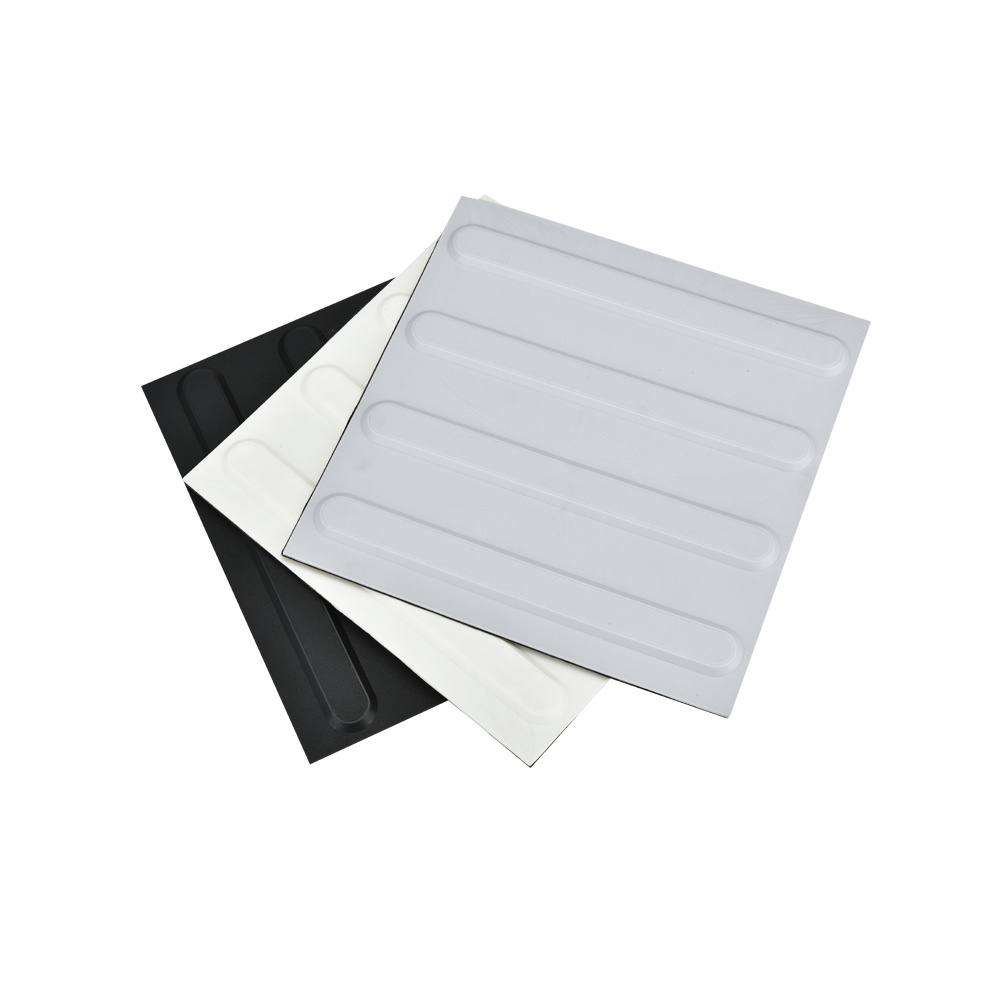TongXi Industrial Zone, YongKang City, ZheJiang Prov., China.
Views: 0 Author: Site Editor Publish Time: 2025-07-12 Origin: Site
Tactile paving tiles are essential for helping visually impaired individuals navigate public spaces safely. But why are they so crucial for independence? These tiles play a key role in guiding people through sidewalks, train platforms, and building entrances. In this post, we’ll explore what tactile paving tiles are and how they enhance safety and mobility for visually impaired individuals.

Tactile tiles are designed with raised elements, typically domes or bars, that provide clear tactile feedback. These raised elements are crucial for guiding visually impaired individuals. The height and spacing of these elements are standardized, usually ranging from 3-5 mm. This ensures that the tactile feedback is easily detectable underfoot, making navigation safer. Standardized designs help maintain consistency in various public spaces, ensuring that individuals can rely on these surfaces to guide them safely.
Color plays a vital role in enhancing visibility. Tactile tiles often feature a high-contrast color, such as yellow, to ensure they stand out against their surroundings. This contrast benefits not only visually impaired individuals but also pedestrians and motorists. Yellow is especially effective as it provides excellent visibility against common background surfaces like asphalt or concrete. The use of contrasting colors ensures that tactile tiles are clearly identifiable, improving safety for everyone.
Tactile tiles come in various shapes and sizes, with square and rectangular tiles being the most common. Standard sizes include 300mm x 300mm for square tiles and 600mm x 300mm for rectangular tiles. The choice of shape and size is essential for different environments. For example, square tiles are ideal for creating grid patterns along sidewalks, while rectangular tiles are often used along platform edges or walking paths. These design choices help make navigation more intuitive and safer for users.
Ceramic tactile tiles are a top choice for their excellent durability and resistance to various weather conditions. These tiles can withstand harsh elements like rain, snow, and extreme temperatures, making them ideal for both indoor and outdoor use. Their smooth yet textured surface makes them easy to maintain, as dirt and debris do not easily cling to them. Ceramic tiles are particularly suitable for high-traffic areas such as train stations, airports, and urban walkways because they are highly resistant to wear and tear. Additionally, they are available in various colors and designs, allowing for both functional and aesthetic integration into public spaces.
Rubber tactile tiles offer a unique combination of flexibility and shock absorption, making them perfect for uneven or rough surfaces. They are commonly used in areas like parks, community centers, or playgrounds, where surfaces may not be perfectly level. These tiles are non-slip, which is particularly valuable in wet or slippery environments, such as outdoor areas exposed to rain. Rubber tiles are lightweight, which simplifies installation compared to heavier materials like ceramic or metal. Their flexibility allows them to adapt to irregular surfaces, making them a versatile choice in various settings. Additionally, rubber is a sustainable material, often made from recycled sources, enhancing their eco-friendly appeal.
Plastic tactile tiles are an affordable and highly customizable option. These tiles are known for their resistance to UV rays, which means they can maintain their color and functionality even when exposed to prolonged sunlight. Many plastic tiles are made from recycled materials, making them an environmentally conscious choice. They are lightweight and easy to install, offering flexibility for different designs and layouts. Plastic tiles are available in a variety of colors and patterns, providing options to match the aesthetic of the surrounding environment. While they are a cost-effective solution, they are also durable enough for use in a wide range of applications, from shopping malls to public parks.
Stainless steel tactile tiles are known for their exceptional durability and corrosion resistance. These tiles are ideal for high-performance areas where durability is a priority, such as near water bodies, industrial facilities, or coastal environments where corrosion might be an issue. Stainless steel provides a modern, sleek look, often preferred in settings where aesthetics are also important, such as in high-end commercial buildings or public spaces. The raised tactile elements are either welded or molded directly onto the surface, ensuring they remain intact and provide reliable feedback for visually impaired individuals. While stainless steel tiles tend to be more expensive, their long-lasting performance and resistance to wear make them an excellent choice for high-traffic or demanding environments.
Tactile paving tiles are essential for visually impaired individuals to navigate public spaces independently. They use distinct surface patterns—typically raised bars, domes, or a combination of both—to provide tactile cues. For straight paths, rows of bars or domes offer a consistent pattern, while turns are signaled by different patterns or transitions in texture. This system allows users to feel the direction and make decisions confidently. These tiles are especially important in high-traffic areas like bus stops, train station entrances, airports, and shopping centers. By creating a tactile map, the tiles guide users safely and efficiently, reducing dependence on others and increasing mobility.
Tactile tiles also play a crucial role in safety by warning users of potential hazards. They are strategically placed to help individuals identify risky areas such as train platform edges, stairways, ramps, and uneven ground. For example, tightly spaced domes are typically used to signal a drop-off, like the edge of a platform or the top of stairs. This tactile cue alerts the user to slow down or stop. On ramps or uneven surfaces, tactile paving helps to prevent falls by signaling a change in the environment. Additionally, hazard warning tiles are useful in areas where surfaces may be slippery or difficult to navigate, such as wet floors or ramps in inclement weather. These tiles contribute significantly to pedestrian safety, ensuring all individuals, particularly those with visual impairments, can move through public spaces without fear of accidents or injuries.
Installing tactile paving tiles requires careful planning and execution. Here’s a step-by-step guide to ensure proper installation:
1. Surface Preparation: Start by cleaning the installation area. Ensure the surface is level, clean, and free of debris.
2. Measuring and Marking: Measure the space where tiles will be laid. Mark the area for proper alignment.
3. Tile Placement: Begin laying the tiles in the predetermined pattern. Press them firmly to ensure they are securely bonded to the surface.
4. Grouting: Fill the gaps between tiles with grout to ensure a smooth and secure finish.
5. Curing Time: Allow the tiles to set for the recommended period before allowing foot traffic.
For urban areas, transport stations, or schools, ensure you select tiles suitable for high-traffic environments. Proper tools like tile cutters, adhesives, and grout spreaders are essential. Make sure the tiles are aligned correctly for long-term durability.
To keep tactile paving tiles functional and safe, regular maintenance is necessary:
● Cleaning Methods: Clean the tiles regularly using mild detergent and water to preserve their texture and color. Avoid abrasive cleaners that could damage the surface.
● Checking for Wear and Tear: In high-traffic areas, check the tiles for damage like cracks or worn-out textures. Immediate repair prevents further damage.
● Maintenance Schedules: Set up periodic inspections, especially in outdoor areas where weather conditions can wear down the tiles faster. Replace damaged or worn tiles promptly to maintain safety.
Proper maintenance ensures tactile tiles continue to provide effective wayfinding and hazard warning for years.
Tactile mats are a flexible alternative to traditional paving tiles. They are often used for temporary installations or in spaces that need movable solutions. The main advantage of tactile mats is their ease of installation, as they can be rolled out quickly. However, they generally have lower durability than tiles and may require more frequent maintenance. The texture of mats varies, offering tactile patterns to guide individuals. These are ideal for areas that don't need permanent installations but may not offer long-term reliability in high-traffic zones.
Painted tactile markings are a cost-effective option for small areas or quick fixes. These markings are often used to complement physical tiles in areas where tactile feedback is needed but tiles aren't feasible. While they are more affordable, their durability is limited. Over time, painted tactile markings can wear down, especially in high-traffic areas. They also don’t provide the same tactile feedback as physical tiles, which may make them less reliable for navigation.
Braille-integrated signage combines tactile elements with Braille text, offering both directional guidance and additional information for visually impaired individuals. While these systems are beneficial in providing comprehensive solutions, they are more complex and expensive to install. Braille signage is often used in indoor settings or protected environments, where it’s less exposed to wear and tear. When combined with tactile paving tiles, they can offer a complete system for accessibility. However, installation and maintenance of these systems can be more challenging due to their complexity.
Tactile paving tiles are a critical component of public transportation systems, ensuring that visually impaired individuals can travel safely and independently. These tiles are used extensively in areas like train platforms, bus stops, and subway stations, guiding users through potentially complex environments. For example, at a metro station, tactile pathways lead passengers to ticket counters, platform edges, and even help identify the locations of elevators or escalators. In busy transportation hubs, where confusion and congestion can occur, tactile tiles provide clear and immediate guidance, making travel more accessible. Their presence not only aids the visually impaired but also ensures a more inclusive environment for everyone. Some stations even use tactile tiles to designate emergency exits, making them an important safety feature. Moreover, transportation authorities are increasingly prioritizing tactile paving as part of their infrastructure development to meet accessibility standards and improve user experience.
Tactile paving has become an essential element in urban design, making public spaces safer and more navigable for individuals with visual impairments. A significant example is the integration of tactile tiles in large public areas such as shopping malls, parks, and sports complexes. In these spaces, tactile tiles are strategically placed along walkways to guide users to key areas like entrances, restrooms, elevators, and even food courts. One successful case study involves a popular shopping center where tactile tiles were laid out to help visually impaired customers move confidently through the complex. The tiles not only assist in wayfinding but also play a vital role in preventing accidents by indicating potential hazards, such as stairs or ramps. Local governments are increasingly adopting tactile paving as part of their commitment to creating inclusive urban environments. These initiatives ensure that all pedestrians, regardless of ability, can access and enjoy public spaces with confidence and ease. The ongoing trend in cities worldwide is to prioritize accessibility, incorporating tactile paving tiles as a core element in their infrastructure planning to meet both legal requirements and improve public safety.

Tactile paving tiles offer significant benefits by enhancing accessibility for visually impaired individuals. They play a crucial role in fostering an inclusive society by making public spaces safer and easier to navigate. Communities should be encouraged to implement tactile paving to improve accessibility. Looking ahead, tactile paving technology will continue to evolve, offering new innovations for better inclusivity.
A: Tactile paving tiles help visually impaired individuals navigate public spaces safely by providing tactile feedback, which enhances their independence and safety.
A: Common materials for tactile tiles include ceramic, rubber, plastic, and stainless steel, each offering different benefits in terms of durability, cost, and application.
A: Installing tactile paving tiles involves preparing the surface, ensuring correct alignment, and securely fixing the tiles. Detailed installation guides and tools are essential for proper placement.
A: Yes, tactile paving tiles are suitable for both indoor and outdoor environments, especially in areas where visually impaired individuals need to navigate safely.
A: Special patterns of tactile tiles, such as closely spaced domes, are used to warn individuals of potential hazards like train platform edges or stairs, helping to prevent accidents.